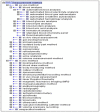Three ontologies to define phenotype measurement data
- PMID: 22654893
- PMCID: PMC3361058
- DOI: 10.3389/fgene.2012.00087
Three ontologies to define phenotype measurement data
Abstract
Background: There is an increasing need to integrate phenotype measurement data across studies for both human studies and those involving model organisms. Current practices allow researchers to access only those data involved in a single experiment or multiple experiments utilizing the same protocol.
Results: Three ontologies were created: Clinical Measurement Ontology, Measurement Method Ontology and Experimental Condition Ontology. These ontologies provided the framework for integration of rat phenotype data from multiple studies into a single resource as well as facilitated data integration from multiple human epidemiological studies into a centralized repository.
Conclusion: An ontology based framework for phenotype measurement data affords the ability to successfully integrate vital phenotype data into critical resources, regardless of underlying technological structures allowing the user to easily query and retrieve data from multiple studies.
Keywords: ontology; phenotype.
Figures







Similar articles
-
The clinical measurement, measurement method and experimental condition ontologies: expansion, improvements and new applications.J Biomed Semantics. 2013 Oct 8;4(1):26. doi: 10.1186/2041-1480-4-26. J Biomed Semantics. 2013. PMID: 24103152 Free PMC article.
-
Analyzing user interactions with biomedical ontologies: A visual perspective.Web Semant. 2018 Mar;49:16-30. doi: 10.1016/j.websem.2017.12.002. Epub 2017 Dec 20. Web Semant. 2018. PMID: 29657560 Free PMC article.
-
OBIB-a novel ontology for biobanking.J Biomed Semantics. 2016 May 2;7:23. doi: 10.1186/s13326-016-0068-y. eCollection 2016. J Biomed Semantics. 2016. PMID: 27148435 Free PMC article.
-
Knowledge Representation and Management, It's Time to Integrate!Yearb Med Inform. 2017 Aug;26(1):148-151. doi: 10.15265/IY-2017-030. Epub 2017 Sep 11. Yearb Med Inform. 2017. PMID: 29063556 Free PMC article. Review.
-
Evaluation of ontology structural metrics based on public repository data.Brief Bioinform. 2020 Mar 23;21(2):473-485. doi: 10.1093/bib/bbz009. Brief Bioinform. 2020. PMID: 30715146 Review.
Cited by
-
Animal QTLdb: an improved database tool for livestock animal QTL/association data dissemination in the post-genome era.Nucleic Acids Res. 2013 Jan;41(Database issue):D871-9. doi: 10.1093/nar/gks1150. Epub 2012 Nov 24. Nucleic Acids Res. 2013. PMID: 23180796 Free PMC article.
-
The Problems of Realism-Based Ontology Design: a Case Study in Creating Definitions for an Application Ontology for Diabetes Camps.AMIA Annu Symp Proc. 2018 Apr 16;2017:1517-1526. eCollection 2017. AMIA Annu Symp Proc. 2018. PMID: 29854221 Free PMC article.
-
Mouse Phenome Database: an integrative database and analysis suite for curated empirical phenotype data from laboratory mice.Nucleic Acids Res. 2018 Jan 4;46(D1):D843-D850. doi: 10.1093/nar/gkx1082. Nucleic Acids Res. 2018. PMID: 29136208 Free PMC article.
-
Ensembl 2018.Nucleic Acids Res. 2018 Jan 4;46(D1):D754-D761. doi: 10.1093/nar/gkx1098. Nucleic Acids Res. 2018. PMID: 29155950 Free PMC article.
-
Rat Genome and Model Resources.ILAR J. 2017 Jul 1;58(1):42-58. doi: 10.1093/ilar/ilw041. ILAR J. 2017. PMID: 28838068 Free PMC article. Review.
References
-
- Bouchard C., Leon A. S., Rao D. C., Skinner J. S., Wilmore J. H., Gagnon J. (1995). The HERITAGE family study. Aims, design, and measurement protocol. Med. Sci. Sports Exerc. 27, 721–729 - PubMed
Grants and funding
LinkOut - more resources
Full Text Sources

